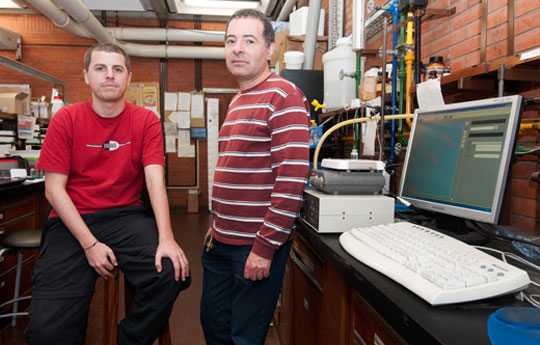CONICET – UBA
Nitroxyl: new advances in the prevention of myocardial infarction and ischaemia
This molecule plays a key role in the cardiovascular system. It could be a great advance in new drugs to treat common heart failures.
After more than ten years of work at Instituto de Química Física de los Materiales, Medio Ambiente y Energía (INQUIMAE, UBA-CONICET), Fabio Doctorovich’s team developed a nitroxyl sensor that holds a great application potential for medical sciences. As part of this process, this year an agreement with a company was signed to use this sensor in the development of pharmacological treatments for cardiovascular pathologies and their consequences.
The nitroxyl is a simple but very reactive inorganic molecule, difficult to detect. Fifteen years ago, very little was known about its basic chemistry, structural characterisation and reactivity, among other characteristics, and therefore its possible biological implications were not known. “It was necessary to fill in the gap in this area of knowledge so after working on nitric oxide (NO) and its reaction with metals for over a decade we decided to deal with HNO”, Doctorovich, principal researcher of CONICET and director of INQUIMAE’s team that developed the sensor.
Researchers explain that in order to contract the cardiac cell has to, at the molecular level, release calcium from a compartment called sarcoplasmic reticulum. This contraction cause heartbeat and activate the circulatory system. The HNO acts on one of the calcium channels of this receptacle and leads to the calcium release and the contraction of the heart. Thus, it increases the contraction of these cells and causes a vasodilator effect.
“The HNO has a differential pharmacological activity and therefore it is an alternative therapy to the treatment with NO, a drug already known for its cardiovascular effects. To assess the effects of the HNO is difficult due to its reactivity, so the device we developed is helpful because it selectively quantifies it, in vivo, and allows us to study how it is released, the velocity and under what conditions, for instance”, Marcelo Martí, independent researcher of CONICET explains.
In 2014, the magazine Accounts of Chemical Research gathered the latest advances of this research team about the study of nitric oxide and nitroxyl and highlighted their relevance in the field. Furthermore, Nature Communications recently published the results of a collaboration with German scientists where, thanks to the use of the sensor developed by Argentine researchers, it was possible to determine the relevant role of the HNO in certain neurovascular mechanisms.
A long way to technology
In 2001, the researchers began to study the interactions of the HNO with metal porphyrins, beginning with iron. The porphyrins are molecules that serve as models of the enzyme active sites so they enable the observation of the interactions of molecules with their environment. For instance, the active site of the haemoglobin for carrying oxygen has a porphyrin with iron.
“Although there were teams that had researched the interaction of complete hemoproteins with HNO, nobody had studied them with these models of most basic chemistry. For this reason, we started to work on the porphyrins to know the characteristics of the HNO”, Doctorovich explains.
Neverthelss, for Martí, the first obstacle they had to encounter were the unique characteristics of these porphyrins.
“The NO and the HNO are very similar, one can become the other. At the same time, the iron porphyrins react with both molecules so they did not serve to distinguish and characterise the HNO separately. But when we began to study manganese porphyrins we obtained good results: they were more selective and we could observe that some reacted with NO and others exclusively with HNO”, Martí explains.
At this point, the scientists posed a new challenge: to develop an electrochemical method to measure the quantity of HNO in one solution, that is to say, to determine the presence and concentration of HNO based on the determination of the electric current by inserting an electrode in the medium.
The electrode or sensor should meet three key conditions to be effective: the porphyrin must be able to bind the HNO at a certain electrode potential and that this generates the signal to measure it. Furthermore, it was necessary for the porphyrin to release the HNO and return to its previous state. And, finally, it was essential for the porphyrin to be selective, that is to say that NO cannot bind to it while in the state in which it has to sense HNO.
“We obtained the signal using the the cobalt porphyrin, and we obtained the best results by depositing it on gold. The most interesting part is that there are several systems in which the HNO is supposed to be but it has never been measured, so with this device it is possible now”, Sebastián Suárez, doctoral fellow of CONICET at the INQUIMAE says.
For Martí, at that moment, they began to intensively interact with other scientist of that field and that was why they set new objectives related to the use of the sensor to understand this molecule in its chemical or biological role. Currently, they have already performed the tests on animal models and managed to obtain a geometry suitable for this purpose: rod shape.
“In contrast to the rest, our device is non-invasive for the only thing that is introduced in the medium is a small portion of a completely inert metal. Besides, through this device we could observe the HNO concentration in real time since the electrode provides an immediate result because it is an electric current that is proportional to the HNO concentration”, Doctorovich remarks.
The researchers began to use the device for drug development to prevent myocardial infarction and strokes.
- By Lucila Espósito
- About the research:
- Fabio Doctorovich. Principal researcher. INQUIMAE.
Marcelo Martí. Independent researcher. INQUIMAE.
Sebastián Suárez. Doctoral researcher. INQUIMAE.
